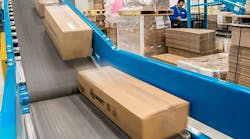Earlier this year, Avnet, Inc. named Chuck Delph president of Avnet Electronics Marketing Americas, replacing longtime leader Ed Smith, who was named senior vice president of the company’s global embedded business. The official transition takes place in July. We asked Delph—a 24-year industry veteran who most recently led Avnet EM Americas’ components sales division—to talk about his plans as leader of the Americas organization and about his outlook on the electronic components industry for the remainder of 2016. Here are some excerpts from our conversation:
Q: You will officially take over as president of Avnet Electronics Marketing Americas July 3. What will your first day on the job look like?
A: We do an awful lot of succession planning at Avnet … It’s not only good for the business, but it’s good for our team, our customers, and our suppliers. So the first day on the job, my fingerprints will already be all over the strategies we have in place. [Because of this planning], it doesn’t feel like I’ve closed one door and opened another. It’s more like an escalator—because of the time we’ve spent on leadership and succession planning.
Q: We talked recently about growth opportunities for the industry, and you mentioned that Mexico is one of the fastest-growing regions for Avnet EM Americas. What actions has Avnet taken there recently and how is your business in Mexico changing?
A: I think what’s interesting about Mexico in particular [is that] the verticals we think are going to grow within the Americas theater—automotive, lighting, the IoT—the acceleration of that growth will continue to happen in Mexico. We see that whether it’s U.S. manufacturers, European manufacturers … people are building these platforms into Mexico. Mexico is going to benefit from that opportunity, and we think [we are well-positioned] there.
I also think people underestimate that there is continual technology growth in Mexico. There is design and new customer starts coming out of that region, so I see Mexico as a supply chain hub, but also [as a place that is] competing well in global economics. I think Mexico continues to be a place that competes well from a supply chain point of view, but I wouldn’t underestimate what Mexico will do from a technical point of view either … Mexico today looks like a very strong economic partner for growth.
We have expanded our facility in Guadalajara to not only support what we’re doing from a growth perspective in Mexico, but also as a support mechanism for Avnet North America overall. We’re leveraging that for the greater good of all of Avnet throughout North America. And we’re continuing to expand our proximity warehouses to stage inventory closer to customers throughout the region.
Q: There is a lot of talk about “disruption” in the supply channel—from new competitors such as Amazon and new technologies such as the IoT, for instance. How do you think these and other disruptive forces are affecting the electronic components supply channel?
A: I think you have to pay attention and understand disruptive threats; you can’t cast them off to the side. [Online competitors] are a good example. The world of value distribution, which is what we provide, is not easy to repeat. There is a differentiation to the services we provide compared to those who want to buy in a point-and-click environment, so we have a unique opportunity now to demonstrate our value, show our value, and explain it to our customers and suppliers alike. We need to show the difference between what we bring to the supply chain and the design chain versus those who have a part on the web for a price.
The greater overall value we provide, and that some of our competitors provide—that’s just not repeatable. It’s not hard, but it is hard work. There is some complexity to it that’s not easy to replicate.
Q: This year, Avnet Inc. hired Eric Williams as vice president of IoT—a newly created position and the first to span both the Electronics Marketing and Technology Solutions businesses. How will this help Avnet EM’s strategy to build business in the IoT segment?
A: There is a movement that’s taken place to create one Avnet, and the IoT is a bridge for that. For many years, we would follow parallel paths with our [Avnet Technology Solutions] counterparts, but the language wasn’t the same. Today, when we talk to our teams at Avnet EM and Avnet TS, they’re talking about cloud, and we’re talking about cloud; they’re talking about data and security, and so are we. Every customer that we call on today is faced with similar challenges that both organizations can bring value to. When I think about disruptive opportunities, this is one that Avnet can provide—from a single component stage all the way to enterprise solutions [and] to the cloud. We can provide services, solutions, technical support and supply chain [programs] across the enterprise. We are in a unique position to provide all of this.
What’s interesting is, our customers don’t see us as Avnet TS or Avnet EM; they see us as Avnet. And again, this really shows the difference between what we bring to the supply chain and the design chain versus those who have a part on the web for a price.
Q: The electronics supply channel continues to be in a slow-growth mode, but many industry leaders have an optimistic long-term view based on the growing amount of electronic content in all aspects of our lives. What is your long-term outlook for the industry?
A: Clearly, we’re facing a mature industry. I’ve always looked at these things and said, ‘The market is the market and what are we going to do about it?’ We ought to spend our time doing the four things we have talked about: build the right leaders, leverage regions that are growing faster than others, look at disruptive competitors that may exist and learn from them a bit without giving away our value, and where there are opportunities to collaborate as one Avnet, don’t miss those opportunities to provide a total solution.
My strategy has always been to find the best of the opportunities and make the most of the situation. You can either let it happen to you, or you can do something about it. We’re doing something about it.








